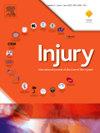Psychological health status after major trauma across different levels of trauma care: A multicentre secondary analysis
IF 2.2
3区 医学
Q3 CRITICAL CARE MEDICINE
Injury-International Journal of the Care of the Injured
Pub Date : 2025-02-01
DOI:10.1016/j.injury.2025.112152
引用次数: 0
Abstract
Introduction
Concentration of trauma care in trauma network has resulted in different trauma populations across designated levels of trauma care.
Objective
Describing psychological health status, by means of the impact event scale (IES) and the hospital anxiety and depression scale (HADS), of major trauma patients one and two years post-trauma across different levels of trauma care in trauma networks.
Methods
A multicentre retrospective cohort study was conducted. Inclusion criteria: aged ≥ 18 and an Injury Severity Score (ISS) > 15, surviving their injuries one year after trauma. Psychological health status was self-reported with HADS and IES. Subgroup analysis, univariate, and multivariable analysis were done on level of trauma care and trauma region for HADS and IES as outcome measures.
Results
Psychological health issues were frequently reported (likely depressed n = 31, 14.7 %); likely anxious n = 32, 15.2 %; indication of a post-traumatic stress disorder n = 46, 18.0 %). Respondents admitted to a level I trauma centre reported more symptoms of anxiety (3, P25-P75 1–6 vs. 5, P25-P75 2–9, p = 0.002), depression (2, P25-P75 1–5 vs. 5, P25-P75 2–9, p < 0.001), and post-traumatic stress (6, P25-P75 0–15 vs. 13, P25-P75 3–33, p = 0.001), than patients admitted to a non-level I trauma centre. Differences across trauma regions were reported for depression (3, P25-P75 1–6 vs. 4, P25-P75 2–10, p = 0.030) and post-traumatic stress (7, P25-P75 0–18 vs. 15, P25-P75 4–34, p < 0.001).
Conclusions
Major trauma patients admitted to a level I trauma centre have more depressive, anxious, and post-traumatic stress symptoms than when admitted to a non-level I trauma centre. These symptoms differed across trauma regions, indicating populations differences. Level of trauma care and trauma region are important when analysing psychological health status.
不同层次创伤护理对重大创伤后心理健康状况的影响:一项多中心二次分析
简介:创伤网络中创伤护理的集中导致了不同的创伤人群在指定的创伤护理水平上。目的:采用影响事件量表(IES)和医院焦虑抑郁量表(HADS)描述创伤网络中不同创伤护理水平的重大创伤患者创伤后1年和2年的心理健康状况。方法:采用多中心回顾性队列研究。纳入标准:年龄≥18岁,损伤严重程度评分(ISS) bbb15,创伤后1年存活。用HADS和IES自我报告心理健康状况。对HADS和IES的创伤护理水平和创伤区域进行亚组分析、单变量和多变量分析。结果:经常报告心理健康问题(可能抑郁n = 31, 14.7%);可能焦虑n = 32, 15.2%;指征为创伤后应激障碍(n = 46, 18.0%)。接受I级创伤中心治疗的应答者报告的焦虑症状(3,P25-P75 1-6比5,P25-P75 2-9, p = 0.002)、抑郁(2,P25-P75 1-5比5,P25-P75 2-9, p < 0.001)和创伤后应激(6,P25-P75 0-15比13,P25-P75 3-33, p = 0.001)比非I级创伤中心治疗的患者更多。据报道,不同创伤区域在抑郁症(3,P25-P75 1-6 vs. 4, P25-P75 2-10, p = 0.030)和创伤后应激(7,P25-P75 0-18 vs. 15, P25-P75 4-34, p < 0.001)方面存在差异。结论:入住一级创伤中心的严重创伤患者比入住非一级创伤中心的患者有更多的抑郁、焦虑和创伤后应激症状。这些症状在不同的创伤区域有所不同,表明了人群的差异。创伤护理水平和创伤区域是分析心理健康状况的重要因素。
本文章由计算机程序翻译,如有差异,请以英文原文为准。
求助全文
约1分钟内获得全文
求助全文
来源期刊
CiteScore
4.00
自引率
8.00%
发文量
699
审稿时长
96 days
期刊介绍:
Injury was founded in 1969 and is an international journal dealing with all aspects of trauma care and accident surgery. Our primary aim is to facilitate the exchange of ideas, techniques and information among all members of the trauma team.

 求助内容:
求助内容: 应助结果提醒方式:
应助结果提醒方式:


